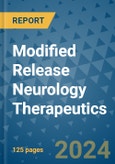The report provides developers, device designers, healthcare marketers, and supply chain participants with a detailed understanding of the economics, technologies, opportunities for injection devices that are designed for patient self-administration. Provider organization business managers, healthcare administrators and investors will also benefit from this study. The study:
- Analyzes and evaluates modified release neurology therapeutics products and assesses the market potential for existing and probable future products
- Analyzes product strategies, technologies and market development issues
- Provides detailed analysis of neurology market segments, market demographics, and therapeutic strategies
- Profiles market sector companies, their product development activities, business strategies, and corporate alliances and affiliations
- Evaluates the impact of economic, technology, and regulatory factors on neurology drug markets
Market Insights
As patients live longer and the prevalence and incidence of chronic ailments increase across the general population, drug developers and their delivery device partners are adapting to address what will become a significant market opportunity. Chronic conditions require drug administration over long periods of time, placing a greater emphasis on self-administration. With the shift away from caregiver interaction, drug safety and compliance/adherence become prominent concerns. These concerns, which are not new, are becoming magnified as the number of powerful new drugs reaching the market increases. For healthcare managers and public health officials, one way to address these issues is less frequent dosing.
Using formulation technologies designed to modulate the effect of therapeutic substances, drug developers are creating formulations that exhibit extended release profiles. These chemistries include polymers such as polyethylene glycol-complexed (PEGylated), which are used to product encapsulated and coated versions of new APIs. The goal is to address the requirement for patient-dependent, and therefore compliance-sensitive, drug treatment protocols such as multiple dosing through controlled release formulations that provide the desired therapeutic effect with dosing of once-a-day or less.
A number of companies - contract research organizations or CROs, - offer a variety of pharmaceutical services to drug developers and marketers, including drug formulation development, niche manufacturing, and pre-clinical evaluation. Formulation development services range from new compounds to modifications of existing products. Some companies offer product modification and line extension services for marketed products facing patent expiration or for products that can benefit from formulation improvements. Modifications of existing products to incorporate improved product characteristics can include enhancement of stability, absorption profiles, taste, and appearance. Product line extensions can include controlled release formulations, as well as new dosage strengths.
Product modifications and line extensions can create the opportunity to target new patient populations and improve patient acceptance of the product. Other formulation services offered on a contract basis include investigation of impurities, contaminants and degradation, the updating of mature products to meet current regulatory standards and laboratory validation services.
Table of Contents
- Executive Summary
- The Neurological Drug Market Dynamics
- The Trend Toward Self-Administration
- Route of Administration
- Innovation in Drug Formulation
- Neurological Drugs and As-supplied Packaging
- Human Engineering/Ergonomics
- Delivering Neurological Drugs via Injection
- Primary Packaging
- Innovation in Injectable Device Designs
- Drug Delivery Device Selection Issues
- Therapeutic Demand Drivers
- Key Market Factors
- MR Neurological Product Analysis
- Proprietary Formulation Technology
- ChroniJect (Oakwood Laboratories/PharmaSophia)
- CriticalMix (Critical Pharmaceuticals)
- Depofoam (Pacira)
- FluidCrystal (Camarus)
- LinkeRx (Alkermes)
- Medisorb (Alkermes)
- Medusa (Recipharm/Avadel)
- Nanocrystals (Alkermes)
- Optisomes (Talon/Spectrum)
- PolyActive (Octoplus)
- Q-Sphera (Midatech Pharma)
- SABER/SAIB (DURECT)
- SynBiosys (Innocore)
- TransCon (Ascendis)
- Physical Process Control Methods
- Supercritical Fluid
- SCF for Nanoparticle Formulations
- Formulplex (Supercritical Solutions)
- Ferro
- SCF extraction of emulsions (SFEE)
- Stability
- Administration Factors
- Therapeutic Market Sectors
- Schizophrenia
- Bipolar Disorder
- Market Sector Analysis and Forecasts
- Key Market Factors
- Economic Factors
- Technology Factors
- Regulatory Factors
- Risk Factors
- Forecasts and Market Data
- Company Profiles
Executive Summary
Large pharmaceutical and biotechnology companies are increasingly pursuing in-licensing to offset lower than expected drug development productivity and surging research costs. Data mining technologies, combined with data from genomics, combinational chemistry and outcome-based medicine, provide opportunities to search for new patterns. By using hypertext type tools, companies are finding it possible to build knowledge bases where scientists can link data and ideas to generate insights into new relationships between population groups, diseases, and treatment.
For long-acting formulations of Injectable drugs, development collaborations typically follow one of two business models. The majority of projects/products are marked by a contractual relationship between the formulation IP developer/holder and the drug developer. The second notable business model is more ambitious and is defined by formulation IP companies that develop long-acting formulations in-house before licensing the marketing rights to a partner, typically in late stage clinical development or after filing an NDA. This is a more powerful financial model, but has a higher level of risk and requires adequate capitalization to finance drug development into or up to Phase 3 trials.
Companies Mentioned
- Alkermes
- Amylin
- AntriaBio
- Ascendis Pharma
- AstraZeneca
- Aurobundo
- Avadel
- Biomarin
- Camurus
- Critical Pharmaceuticals
- DURECT
- Eli Lilly
- Enzon
- Ipsen
- Janssen
- NanOlogy
- Novartis
- Oakwood Laboratories/PharmaSophia
- OctoPlus
- Pacira
- PhaseBio Pharmaceuticals
- Recipharm AB
- Roche
- Sanofi
- Taiwan Liposome Company
- Xbrane Bipharma








